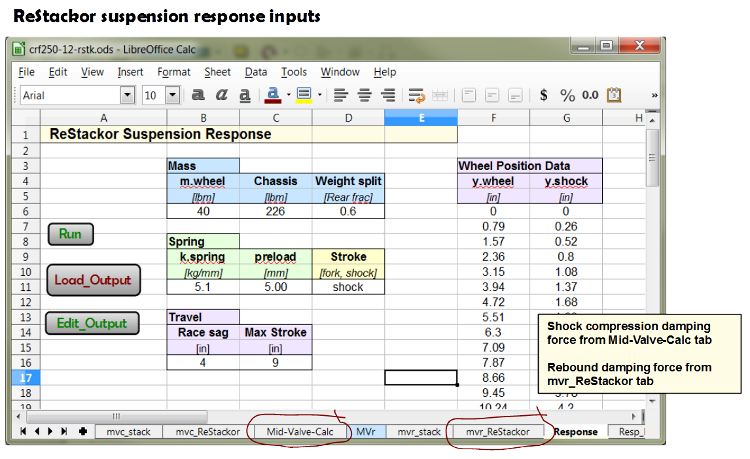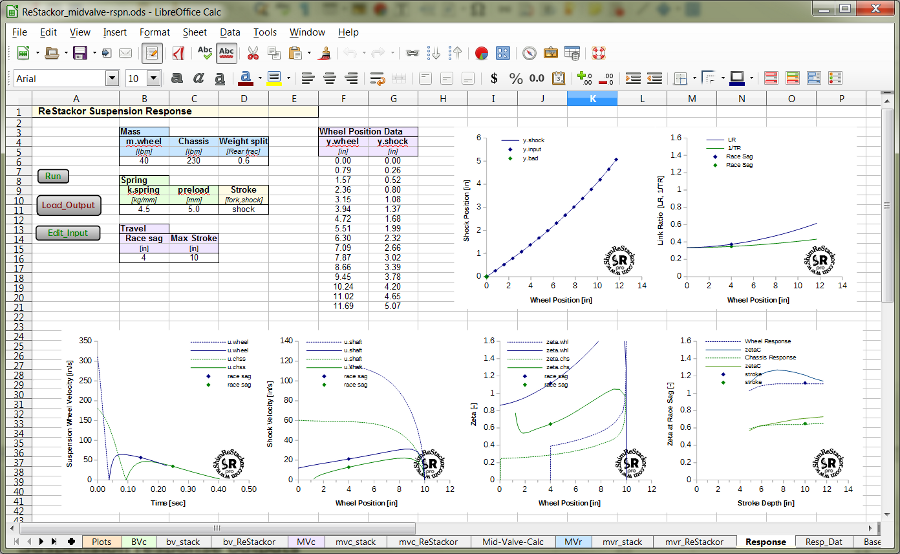

Response
Outputs

Suspension Response Inputs
ReStackor suspension response calculations run on the "Response" tab of the mid-valve spreadsheets. Inputs describe the bikes mass, spring rate, link ratio and stroke depth. Inputs are described below.

Response calculations use the shocks compression damping force given on the "Mid-Valve-Calc" tab of ReStackor mid-valve spreadsheets. Those outputs are generated by the mv_Analysis button run on the "Plots" tab of ReStackor spreadsheets. The shocks rebound damping force is computed on the MVr spreadsheet tab with outputs loaded onto the "mvr_ReStackor" output tab.
![]()
ReStackor Suspension Response Inputs
Mass:
m.wheel [=] Wheel un-sprung weight. Includes wheel, tire, brake caliper, fork stanchion tubes and everything else bouncing up and down with the wheel
Chassis [=] Curb weight of bike including wheel weight, fuel and accessories
Weight split [=] Fraction of bike curb weight on rear wheel, w.rear/w.curb
Spring:
k.spring [=] Spring rate
preload [=] Preload on spring at full extension
Stroke:
Stroke [=] Suspension stroke type, one of {fork, shock, front, rear}
fork: Calculations assume front chassis weight is supported by two fork legs with equal damping and spring rate in each leg. For a single function fork (SFF) use the shock input below and reverse the front/rear weight spilt (1-Weight split).
shock: Calculations assume rear chassis weight is supported by the spring rate and damping of a single shock
front: Spec for car. Calculations assume front chassis weight is supported by two shocks, two spring and two wheels
rear: Spec for car. Calculations assume rear chassis weight is supported by two shocks, two springs and two wheels.
Travel:
Race sag [=] Normal suspension ride height. Typically 1/3 of suspension travel
Max Stroke [=] Stroke depth for calculations. Recommend bump rubber position as maximum stroke depth for suspension tuning
Wheel Position Data:
At least four wheel/shock position measurements are needed, maximum of 39. Adding more position measurements improves the fidelity of the suspension link ratio curve.
y.wheel [=] Wheel stroke distance measured from full extension
y.shock [=] Shock stroke depth measured from full extension
![]()
Suspension Response Calculations
To run suspension response calculations you must first determine the shocks compression and rebound damping force. The calculation process is shown below:
-
Calculate compression damping:
-
BVc tab: Fill in and run the shocks compression adjuster or base valve for fork calculations
-
MVc tab: Fill in and run the shocks mid-valve compression stack
-
Plots tab: Hit the "mv_Analysis" and "Load_Output" buttons to compute the combined compression damping force of the shocks base valve and mid valve. Outputs are loaded onto the "Mid_Valve_Calc" tab of the spreadsheet
-
-
Calculate rebound damping:
-
MVr tab: Fill in and run the shock rebound damping stack. Outputs are loaded onto the "mvr_ReStackor" output tab
-
-
Calculate suspension Response:
-
Response tab: Fill in the stroke data and hit the "Run"/"Load_Output" buttons. Multiple cases can be run and each cases uses the shocks damping force data loaded on the "Mid_Valve_Calc" and "mvr_ReStackor" tabs of the spreadsheet.
-

